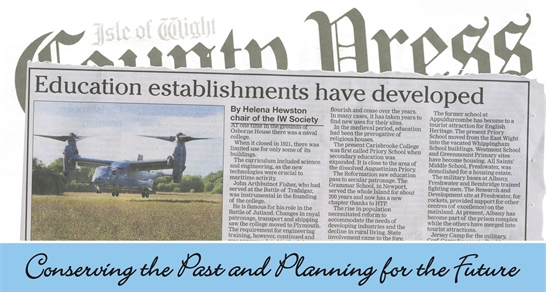November 2017
By Helena Hewston
At one time in the grounds of Osborne House there was a Naval College. A national centre for the training and education of the future officers for the defence of the realm. When it closed in 1921 there was limited use for only some of its buildings. The curriculum had included science and engineering as their use and implementation were crucial to maritime activity. John Arthbutnot Fisher who had served at the Battle of Trafalgar was instrumental in the founding of the college. He is famous for his role in the Battle of Jutland in WW1. Changes in royal patronage, transport and shipping saw the college moved to Plymouth. The requirement for engineering training, however, continued and was accommodated in the JS White and Saunders Roe apprenticeships. This college is just one of several educational establishments, on the Isle of Wight, to flourish and cease over the years. In many cases it has taken years to find new uses for their sites.
In the Medieval period education had been the prerogative of religious houses. The present Carisbrooke College was first called Priory School when secondary education was expanded, It is close to the area of the dissolved Augustinian Priory. The Reformation saw education pass to secular patronage. The Grammar School, in Newport, served the whole island for about two hundred years and is now awaiting a new chapter in its existence. This comes after the demise of the Grammar School system on the Island and other involvements in youth provision. The rise in population necessitated reform to accommodate the needs of developing industries and the decline in rural living. State involvement has come to the fore.
Education and training continues to flourish in the private sector, with Ryde School, Upper Chine and the former Bembridge School. Upper Chine has become a site for housing. Bembridge School mainly supports the boarding part of Ryde School and the former school at Appledurcombe has become to a tourist attraction for English Heritage. The present Priory School moved from the East Wight into the vacated Whippingham School buildings. The Westmont School and Greenmount Primary site in Ryde have become housing. All Saints Middle School Freshwater was demolished for a housing estate. The Naval College is now chiefly car park but some the Officers Quarters at the entrance to Osborne for the general public are characteristic of the architecture and style of the venture.
The military bases at Albany, Freshwater and Bembridge played a part in the necessary training and skills required by fighting men. The Research and Development site at Freshwater for rockets provided support for other centres (of excellence) on the mainland. At present Albany has become part of the prison complex while the others have merged into tourist attractions.
Jersey Camp for the military, Corfe Camp for Scouts, Bouldnor Forest for environmental training, Cowes for sailing through USKA, are just some of the present sites with a defined function, but there are many other pieces of land providing training and education with recreation as a necessary part of Island life.
The Isle of Wight College changed from a technical college to one of Further Education in the 1970s. It continues to grow and develop as with the new building in East Cowes. Modern construction is designed to facilitate change which will continue to add to history and some will become to conservation projects with more than a blue plaque on a wall.
[Go Back]

